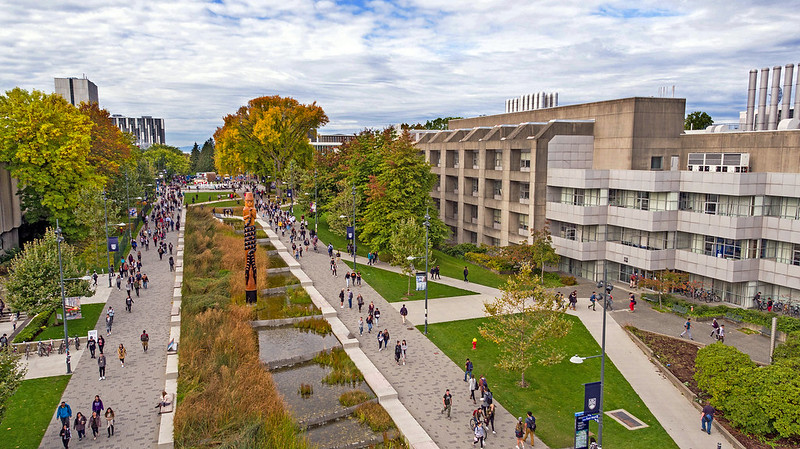Media studies students take hands-on classes in creative writing and visual art, while studying the social, cultural, and political impacts of media in courses on journalism, literature, and film.
This stream fulfills five of the six course requirements for the first year of the Bachelor of Media Studies. Students who have an affinity for making art, analyzing books and films, consuming and discussing contemporary media will find this stream a good fit.
I found CAP to be a great transition into university life. The media studies stream provided a wide range of different courses so that I could experiment with different art disciplines. I found it comforting to know everyone in all of my classes and was able to form new relationships. The small class sizes also helped me engage directly with the professors.
Courses: Term One
In the first term, students will enrol in CAP 100 (fulfills the academic writing requirement), Creative Writing, and Film Studies. Through the study of film and through their own academic research and creative writing projects, students will learn how to appreciate and contribute to scholarly conversations and contemporary media.
Analysis of and practice in academic research and writing in the social sciences and the humanities. Restricted to students in the Coordinated Arts Program. Credits count toward the Writing Component of the Faculty of Arts Writing and Research Requirement.
This course is not eligible for Credit/D/Fail grading.
For more information about the connections between CAP 100 and CAP 101, please visit this page.
CRWR_V 213-CAP (Th 3:30-5) - Instructor: TBA
An exploration of and practice in writing for new media, including podcasting, blogging, and writing for websites, games, and online environments. Manuscript submission is not required for admission.
CINE_V 100-004 (M 2-5:30) - Instructor: TBA
Basic aesthetic, economic, sociological, and technological aspects of film. Credit will be granted for only one of FIST_V 100 or CINE_V 100. Equivalency: FIST_V 100
Courses: Term Two
In the second term, students transition from CAP 100 to CAP 101, while being introduced to the studies of Visual Arts and Journalism. In addition, technical lab/workshop hours in visual arts class will equip students with the technical skills to create and critique visual media, while journalism class will introduce students to various journalistic skills and ethics.
Applications of research and writing skills in the context of literary, cultural, and media analysis. Topics integrate CAP stream themes and vary each year. Restricted to students in the Coordinated Arts Program.
This course is not eligible for Credit/D/Fail grading.
For more information about the connections between CAP 100 and CAP 101, please visit this page.
VISA_V 110-227 (M 1-2) - Instructor: TBA
Foundation instruction in techniques and approaches to digital practice. The nature of digital technologies and their role in contemporary culture will be examined.
JRNL_V 100-A_227 (MWF 10-11) - Instructor: TBA
Development of new media technologies, their applications, and their cultural, political, and social impacts.
Sample Projects
Self-reflection paper/podcast
Students read stories from Legends of Vancouver, a collection of primarily Squamish stories retold by E. Pauline Johnson. They then visit the sites of selected stories in person to collect observations about the contemporary location, and compose either a written paper or a recorded podcast about the difference it makes to their understanding of this space to become aware of its Indigenous cultural significance. This assignment gives students the chance to practice the research method of autoethnography, as they learn how to frame their personal experience as a legitimate part of scholarly research in Indigenous studies and anthropology. They also have the option to add to skills they have already developed in their CRWR 213 course's podcast script assignment, by both scripting and recording a podcast which they may share with an audience of their peers.
Media object group discussion
Students write brief responses summarizing a contemporary media controversy or cultural object of their own choosing, and framing their critical response to it through Stuart Hall’s account of reception theory. These responses are uploaded to the course website and read by a group of their peers, to form the basis for a twenty-minute discussion in which only their fellow group members attend and participate. The assignment gives students a chance to apply course concepts to new contexts, to practice presenting their ideas in a low-stakes spoken format, and to build rapport with peers.
UBC’s Centre for Community Engaged Learning (CCEL) project
The Media Studies stream will be working with a media-focused community organization and working on a related media project in one or more courses.
Appropriation Project
Starting with the dissection and analysis of a chosen moving image source from popular culture, students appropriate the footage into a new video artwork. Sources are obtained from already circulating artifacts such as film, television, talk shows, commercials, news, cartoons, video games or Vlogs, and are used to create a new artwork by new juxtapositions in editing, alterations, or other effects that reveal, expose or changes the way one understands the meaning of the original footage.
Tumblr Literary Project
Students will spend the last month of the semester working primarily on the Tumblr Literary Project that marks the third and final writing assignment in this class. Through a series of weekly collaborative Tumblr Literary workshops, students will build a multimedia Tumblr site showcasing three original pieces of postcard fiction or creative non-fiction of a similar length. Sampling work from across the web, students will furnish the site with images, video, animation, and text that works to shed new light on and assign new meaning to their writing.
Group presentations
Students will be assigned in groups to present the history and context behind major new media and journalism events.
Tweeting and Blogging
Students will be assigned in groups to use Twitter and an in-class blogging tool to report on class presentations.
